4.21.2006
Extremes in New Orleans
We had never been, of course, before Katrina. And it's hard to believe that the character and spirit of the city we experienced has been diminished at all. But visiting New Orleans today is certainly a bit surreal.
As you fly in, the seemingly endless expanse of Lake Ponchartrain gives way to a landscape dotted with blue FEMA tarps. But other than that, there isn't any large-scale damage visible from the air. There was no one in the taxi line, but a lot of taxis, and soon I found myself hurtling down the I-10 (how many exits from Washington/Fairfax?) with a Haitian driver simultaneously shouting on his cellphone in Creole and blasting a Christian Rock FM station. Quite a combination.
Outside the French Quarter, where most of the hotels are, it was dark and relatively empty. During the storm, the floodwaters came up to Canal Street, which is the divider between the downtown district and "The Quarter," but didn't cross. Today, in daylight, you can actually see a dirty line on most buildings indicating the level of flooding. A lot of physical damage, it seemed, had been cleaned up, but there were a few boarded or broken windows, some condemned buildings. Businesses, hotels, and restaurants were open, but many with limited hours because of staff shortages. The only Starbucks, in the lobby of the Sheraton, was only open for a couple of hours each morning. I made do with McDonalds when I didn't make it to the 'bucks before they closed. I know, I really am a trooper.

Cross Canal Street into the French Quarter and you're in a different world, still the magical place that we've all heard about. As we found it, It wasn't as crowded as it would have been on a normal sunny April weekend. But the bars were open, the street bands were playing around Jackson Square, the tables at Cafe Du Monde were covered in powdered sugar, and the daiquiris were flowing on Bourbon Street. At night, the party intensified. Walking through the human circus that is Bourbon Street on a Saturday Night, it's difficult to imagine its intensity and volume before Katrina, or during Mardi Gras. Our favorite spots were on the streets nearby. One particular hangout to recommend: Sidebar, which was a popular crew hangout -- friendly bartenders and really good food that was actually more like LA fare than the typical Cajun stuff. They make an incredible chicken sandwich and I also had the best Mahi Tacos I've ever tasted. And yeah, that's saying something.

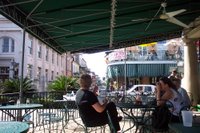
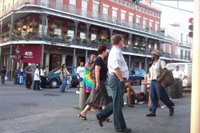
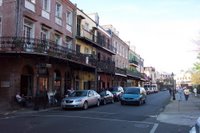
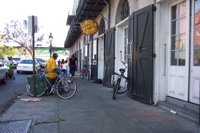

Liz had finished her three plus week commitment, and as we hung out for a long weekend the production gods smiled on us and Gregg got an extra day off.



The food. Where to begin. If you've never had Cajun/Creole, the only way to describe it, other than by its frequent use of shrimp, crawfish, spices etc., is as a cuisine of attrition. It's like the chefs thought this stuff up high, on a dare, or both. It's blackened, its fried in butter, it's stuffed with cheese, or crabmeat, or take your pic, it's smothered in gravy, sausage, shrimp etc. Magnificent excess. One of the best meals I've ever had was at Paul Prudhomme's restaurant, K-Paul's, which Gregg posted about below. My blackened/stuffed/smothered/covered/nine thousand calorie pork chop was amazing, and Gregg's veal/crabmeat/unholy madness was even better. We had fried green tomatoes, turtle soup, cheese-stuffed sausage, and some monstrous chocolate thing that probably needed a surgeon general's warning. Oh, and I had a green salad, too. They say that Chef Paul, who bears an uncanny resemblance to Dom Deluise, is so fat now that he rides around on a motorized tricycle. But beyond this one particular restaurant, all the food was great, from the original Muffaletta sandwiches at Central Grocery to the amazing gumbo served by most establishments around the quarter.
But the other extreme is not hard to find. Drive a short distance from this land of splendours and you find a landscape that can only be described as apocalyptic -- where the destruction wrought by Katrina's floods is still starkly apparent. The Ninth Ward. The destruction -- miles upon miles of twisted, wrecked, pulverized homes, overturned cars and trucks, the detritus of an entire community -- was surreal. I think it's fair to say that until you've seen this kind of thing up close, it's difficult to even conceptualize.
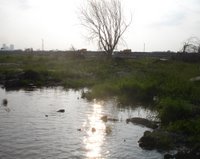
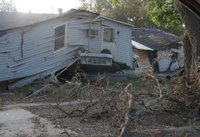



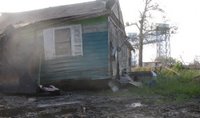
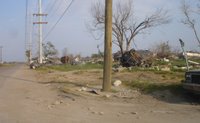
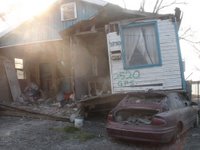
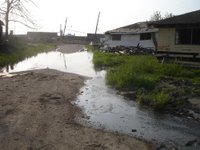


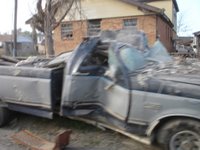


Gregg had been here several weeks before, as they shot a sequence for the film among the devastation; he told us, amazingly, that it looked even worse then. That was hard to imagine. The streets, at least, were clear, and we could drive easily among the twisted remains of houses. We saw only a handful of other people. Every so often we'd come upon someone picking through the wreckage of a home or business. And we passed several other cars, all of them filled with people like us -- cruising slowly past, cameras out, jaws hanging open in disbelief. We experienced it up close. But it's like it was a f*cking tourist attraction. Can you believe it, that eight months later, this place still looks like this? Who's to blame? It's easy to point the finger at the traitor squatting in the oval office and the incompetency of the response at the federal level, but there's a level of corruption in local politics in this part of the country that most of us can scarcely comprehend. . .
Say a prayer for the city of New Orleans and its people. It's an amazing place, and we hope to return soon.
-jw
As you fly in, the seemingly endless expanse of Lake Ponchartrain gives way to a landscape dotted with blue FEMA tarps. But other than that, there isn't any large-scale damage visible from the air. There was no one in the taxi line, but a lot of taxis, and soon I found myself hurtling down the I-10 (how many exits from Washington/Fairfax?) with a Haitian driver simultaneously shouting on his cellphone in Creole and blasting a Christian Rock FM station. Quite a combination.
Outside the French Quarter, where most of the hotels are, it was dark and relatively empty. During the storm, the floodwaters came up to Canal Street, which is the divider between the downtown district and "The Quarter," but didn't cross. Today, in daylight, you can actually see a dirty line on most buildings indicating the level of flooding. A lot of physical damage, it seemed, had been cleaned up, but there were a few boarded or broken windows, some condemned buildings. Businesses, hotels, and restaurants were open, but many with limited hours because of staff shortages. The only Starbucks, in the lobby of the Sheraton, was only open for a couple of hours each morning. I made do with McDonalds when I didn't make it to the 'bucks before they closed. I know, I really am a trooper.

Cross Canal Street into the French Quarter and you're in a different world, still the magical place that we've all heard about. As we found it, It wasn't as crowded as it would have been on a normal sunny April weekend. But the bars were open, the street bands were playing around Jackson Square, the tables at Cafe Du Monde were covered in powdered sugar, and the daiquiris were flowing on Bourbon Street. At night, the party intensified. Walking through the human circus that is Bourbon Street on a Saturday Night, it's difficult to imagine its intensity and volume before Katrina, or during Mardi Gras. Our favorite spots were on the streets nearby. One particular hangout to recommend: Sidebar, which was a popular crew hangout -- friendly bartenders and really good food that was actually more like LA fare than the typical Cajun stuff. They make an incredible chicken sandwich and I also had the best Mahi Tacos I've ever tasted. And yeah, that's saying something.






Liz had finished her three plus week commitment, and as we hung out for a long weekend the production gods smiled on us and Gregg got an extra day off.



The food. Where to begin. If you've never had Cajun/Creole, the only way to describe it, other than by its frequent use of shrimp, crawfish, spices etc., is as a cuisine of attrition. It's like the chefs thought this stuff up high, on a dare, or both. It's blackened, its fried in butter, it's stuffed with cheese, or crabmeat, or take your pic, it's smothered in gravy, sausage, shrimp etc. Magnificent excess. One of the best meals I've ever had was at Paul Prudhomme's restaurant, K-Paul's, which Gregg posted about below. My blackened/stuffed/smothered/covered/nine thousand calorie pork chop was amazing, and Gregg's veal/crabmeat/unholy madness was even better. We had fried green tomatoes, turtle soup, cheese-stuffed sausage, and some monstrous chocolate thing that probably needed a surgeon general's warning. Oh, and I had a green salad, too. They say that Chef Paul, who bears an uncanny resemblance to Dom Deluise, is so fat now that he rides around on a motorized tricycle. But beyond this one particular restaurant, all the food was great, from the original Muffaletta sandwiches at Central Grocery to the amazing gumbo served by most establishments around the quarter.
But the other extreme is not hard to find. Drive a short distance from this land of splendours and you find a landscape that can only be described as apocalyptic -- where the destruction wrought by Katrina's floods is still starkly apparent. The Ninth Ward. The destruction -- miles upon miles of twisted, wrecked, pulverized homes, overturned cars and trucks, the detritus of an entire community -- was surreal. I think it's fair to say that until you've seen this kind of thing up close, it's difficult to even conceptualize.














Gregg had been here several weeks before, as they shot a sequence for the film among the devastation; he told us, amazingly, that it looked even worse then. That was hard to imagine. The streets, at least, were clear, and we could drive easily among the twisted remains of houses. We saw only a handful of other people. Every so often we'd come upon someone picking through the wreckage of a home or business. And we passed several other cars, all of them filled with people like us -- cruising slowly past, cameras out, jaws hanging open in disbelief. We experienced it up close. But it's like it was a f*cking tourist attraction. Can you believe it, that eight months later, this place still looks like this? Who's to blame? It's easy to point the finger at the traitor squatting in the oval office and the incompetency of the response at the federal level, but there's a level of corruption in local politics in this part of the country that most of us can scarcely comprehend. . .
Say a prayer for the city of New Orleans and its people. It's an amazing place, and we hope to return soon.
-jw

























